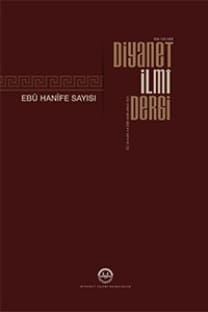EBÜ’L-MUÎN EN-NESEFÎ’YE GÖRE HÜSÜN VE KUBUH MESELESİNİN TAHLİLİ
ANALYSIS OF THE ISSUE OF HUSN AND QUBH ACCORDING TO ABU AL-MU’IN AL-NASAFI
___
- Arslan, Hulusi - Bozkurt, Mustafa. Sistematik Kelâm. 1. Baskı. Ankara: Türkiye Diyanet Vakfı Yayınları, 2015.
- Atay, Hüseyin. “Ebü‟l-Muîn en-Nesefî’nin Semantik Metodu”. Tebṣıratü’l-edille fî uṣûli’d-dîn. 1. Ankara: Diyanet İşleri Başkanlığı Yayınları, 2004.
- Cürcânî, Seyyid Şerif. Muʿcemü’t-taʿrîfât. Thk. Muhammed Sıddik el Minşârî. 1. Baskı. Kahire: Darü’l-Fazile, 2004.
- Cüveynî, İmâmü’l-Haremeyn Kitâbü’l-İrşâd. Trc. Adnan Bülent Baloğlu v.dğr. 2. Baskı. Ankara: Türkiye Diyanet Vakfı Yayınları, 2012.
- Çelebi, İlyas. “Hüsün ve Kubuh”. Türkiye Diyanet Vakfı İslâm Ansiklopedisi. TDV İslâm Araştırmaları Merkezi. Erişim: 24 Kasım 2019. https:// islamansiklopedisi.org.tr/husun-ve-kubuh.
- Ebu Sena, Mahmud b. Zeydullah. Kitabu’t-temhid li kavâidi’t-tevhid. Thk. Abdü’l-Mecid Turkî. Beyrut: Dâru’l-Garbi’l-islam, 1995.
- Emin, Ahmed. Kitabü’L-Ahlak. Kahire: ts. Eş‘arî, Ebü’l-Hasen Alî b. İsmâîl el-. Maḳālâtü’l-İslâmiyyîn. Thk. Muhammed Muhyiddin Abdul Hamid. 1. Baskı. Kâhire: Mektebetü’n-Nehce, 1950.
- Gölcük, Şerafeddin. Bakıllani ve İnsanın Fiilleri. Ankara: Türkiye Diyanet Vakfı Yayınları, 1997. Gölcük, Şerafeddin - Toprak, Süleyman. Kelâm. 4. Baskı. Konya: Tekin Kitabevi, 1998.
- Harpûtî, Abdullatif. Tenḳīḥu’l-kelâm fî ʿakāʾid-i ehli’l-İslâm. Trc. Fikret Karaman - İbrahim Özdemir. 1. Baskı. Ankara: TDV Elazığ Şubesi Yayınları, 2000.
- İbn Manzur, Ebü’l-Fazl Cemâlüddîn Muhammed b. Mükerrem. Lisânü’l-ʿArab. 1. Baskı. 10 Cilt. Beyrut: Daru’l-Kutubi’l-İlmiyye, 2003.
- İsfahânî, Ebü’l-Kāsım Hüseyn b. Muhammed er-Râgıb el-. el-Müfredât fî ġarîbi’l-Ḳurʾân. Beyrut: 2002.
- Kâdı Abdulcebbar, İbn Ahmed el-esed Âbâdi. Şerḥu’l-uṣûli’l-ḫamse (Mu’tezile’nin Beş İlkesi). Trc. İlyas Çelebi. 1. Baskı. 3 Cilt. İstanbul: Türkiye Yazma Eserler Kurumu Başkanlığı, 2013.
- Kâdı Abdülcebbâr. Şerhu usûli’l-hamse. Thk. Abdülkerim Osman. Kâhire: Mektebetü’l-üsre, 2009.
- Kâdı Abdülcebbâr, Ebü’l-Hasen Kâdı’l-kudât Abdülcebbâr b. Ahmed. el-Muğnî fî ebvâbi’t-tevhîd ve’l-adl. Thk. Mahmud Kasım. ts.
- Kâdı Abdülcebbâr, Ebü’l-Hasen Kâdı’l-kudât Abdülcebbâr b. Ahmed. el-Muġnî fî ebvâbi’t-tevḥîd ve’l-ʿadl. Thk. Muhammed Ali Neccar - ve Abdülhalim Neccar. Teklif Yayınları, ts.
- Kādî Abdülcebbâr, Ebü’l-Hasen Kādı’l-kudât Abdülcebbâr b. Ahmed. el-Muġnî fî ebvâbi’t-tevḥîd ve’l-ʿadl. Thk. Mahmud Hudayrî. Trc. Hulusi Arslan. ts.
- Mâtürîdî, Ebû Mansûr Muhammed b. Muhammed b. Mahmûd el-. Kitâbü’t-Tevḥîd. Thk. Bekir Topaloğlu - Muhammed Aruçi. İstanbul: İrşad Kitap Yayın Dağıtım, ts.
- Mâtürîdî, Ebû Mansûr Muhammed b. Muhammed el-. Kitabu’t-Tevhîd Tercemesi. 6. Baskı. Ankara: TDV İslâm Araştırmaları Merkezi, 2014.
- Nesefî, Ebü’l-Muîn Meymûn b. Muhammed b. Muhammed b. Mu‘temid. Tebṣıratü’l-edille fî uṣûli’d-dîn. Thk. Hüseyin Atay - ve Şaban Ali Düzgün. 1. Baskı., 2 Cilt. Ankara: Diyanet İşleri Başkanlığı Yayınları, 2003.
- Nesefî, Ebü’l-Muîn Meymûn b. Muhammed b. Muhammed b. Mu‘temid. Tevhidin Esasları (et-Temhîd li-ḳavâʿidi’t-tevḥîd). Trc. Hülya Alper. 4. Baskı. İstanbul: İz Yayıncılık, 2017.
- Nesefî, Ebü’l-Muîn Meymûn b. Muhammed en-. Tebṣıratü’l-edille fî uṣûli’d-dîn. Ed. Hüseyin Atay. 2. Baskı. 2 Cilt. Ankara: Diyanet İşleri Başkanlığı Yayınları, 2004.
- Nesefî, Ebü’l-Muîn Meymun b.Muhammed. Bahrü’l-kelâm. Thk. Muhammed Salih el Ferfur. 2. Baskı. Şam: Mektebetü Dari’l-Ferfur, 2000.
- Râzî, Fahreddin Muhammed b. Ömer b. Hüseyin. el-Muḥaṣṣal (Kelâma Giriş). Trc. Hüseyin Atay. Ankara: Kültür Bakanlığı Yayınları, 2002.
- Seyyid Şerif Cürcânî. Şerḥu’l-Mevâḳıf. Beyrut: Daru’l-Kutubi’l-İlmiyye, t.y. Şemseddin Sâmi. Kāmûs-ı Türkî. 1. Baskı. İstanbul: İdeal Yayınları, 2012.
- Teftâzânî, Sa’du’d-din. Şerhu’l-ʿakāʾid. Trc. Talha Hakan Alp. 3. Baskı. İstanbul: İFAV Yayınları, 2017.
- Topaloğlu, Bekir - Çelebi, İlyas. Kelâm Terimleri Sözlüğü. 5. Baskı. Ankara: İslamî Araştırmalar Merkezi, 2017.
- Yavuz, Yusuf Şevki. “Ebü’l-Muîn en-Nesefî”. Diyanet İslam Ansiklopedisi. İstanbul: İslamî Araştırmalar Merkezi, ts. Erişim: 11 Kasım 2019.
- Yazıcıoğlu, Mustafa Sait. “Mâtürîdî Kelâm Ekolünün İki Büyük Sîması: Ebû Mansûr Mâtürîdî ve Ebû’l-Muîn Nesefi”. Ankara Üniversitesi İlahiyat Fakültesi İslami İlimler Enstitüsü Dergisi 27 (1985): 281-298.
- ISSN: 1300-8498
- Yayın Aralığı: 4
- Başlangıç: 1956
- Yayıncı: -
OSMANLI DÖNEMİNDE CAMİLERDE KUR’ÂN OKUNMASIYLA İLGİLİ GÖREVLİLER
ÂMİRÎ (Ö. 381/992) VE HÂRİZMÎ’NİN (Ö. 387/997) İLİMLER TASNİFİNDE HADİS İLMİNİN YERİ
ALİ BİN EBÛ ṬALHA'NIN ĠARÎBU'L-ḲUR’ÂN İLMİ ÖZELİNDE ṬABERÎ’NİN TERCİHLERİNDEKİ YERİ
İSLÂM VE BATI KÜLTÜRÜ AÇISINDAN KENT, MUAŞERET VE UYGARLIK İLİŞKİLERİ
EBÜ’L-MUÎN EN-NESEFÎ’YE GÖRE HÜSÜN VE KUBUH MESELESİNİN TAHLİLİ
ALİ BİN EBÎ T. ALHA’NIN G . ARÎBU’LK. UR’ÂN İLMİ ÖZELİNDE T.ABERÎ’NİN TERCİHLERİNDEKİ YERİ
MÂTÜRÎDÎ’NİN TE’VÎLÂTÜ’L-KUR’ÂN’DA BAZI TASAVVUFÎ KAVRAMLARA YAKLAŞIMI
EVLENMENİN HÜKMÜ (ŞER’î SIFATI) VE BU KONUDA İMAM ŞÂFİÎ’YE NİSPET EDİLEN GÖRÜŞ
GAZZÂLÎ’NİN EYYÜHE’L-VELED ADLI ESERİNİN İÇERİK VE YÖNTEMİNİN PEDAGOJİK AÇIDAN İNCELENMESİ
